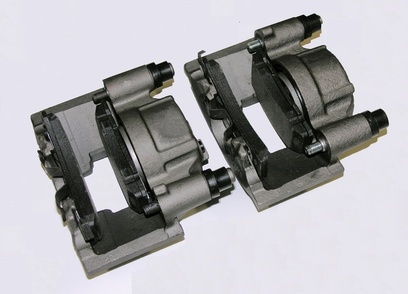
The brake calipers are the main components that house the brake pads. When the brake pedal is pushed down, the brake fluid pressurizes against the cylinder inside of the brake caliper. The cylinder then pushes the inner and outer brake pads to the flat surface of the brake rotors to stop the vehicle. When the brake calipers malfunction, the cylinder inside of the brake caliper will not be able to push the brake pads to the brake rotor and the vehicle will not be able to stop.
Park the vehicle in an area where the surface or the ground is level. Open the hood and remove the cap from the brake fluid container. Then, lay the hood back down but do not close it all the way.
Loosen the lug nuts from the front wheels with the lug wrench or a tire tool.
Slide the floor jack up under the vehicle and jack the vehicle up from the front cross frame or the front axle. Once the vehicle is high enough up in the air, locate the front jacking points on both sides of the vehicle and position the jack stands under both points. Lower the jack so that the vehicle comes to a secure stop on top of the stands.
Unscrew the lug nuts from the front wheels. Then, slide the wheels off the hubs and place the wheels face down so that they don't roll away.
Look on the side of the front driver-side brake rotor and you will see the brake caliper. The caliper will have two upper and lower mounting bolts in the rear of the caliper. Remove the two mounting bolts either with the 1/2-inch drive ratchet and a socket or the appropriate-size Allen wrench.
Slide the end of the pry bar into the opening at the top of the brake caliper and pry the outer brake pad towards the brake rotor. This will loosen the brake caliper's grip on the brake rotor.
Grab the brake caliper with your hand and slide it off the brake rotor. Hang the brake caliper to the nearest suspension component with the bungee cord.
Inspect the brake pads. If the brake pads are showing signs of early wear, then it could be a sign of a bad caliper. This would mean the the caliper is not fully compressing inside of the caliper housing and the brake pads are dragging against the brake rotor as the vehicle is driving down the road.
Remove the inner-side brake pad from the inside of the brake caliper. Slide the C-clamp inside of the brake caliper and position the C-clamp so that it will be able to compress the caliper cylinder.
Start turning the C-clamp towards the cylinder very slowly. If the cylinder will not move or is hard to compress, the caliper needs to be replaced. If you are able to fully compress the caliper cylinder with the C-clamp, try to see if the cylinder will come back out of the caliper.
Go back to the top of the car and get into the driver's seat. Crank the engine and push the brake pedal all the way down and hold it down for at least 10 seconds. Then, release the brake pedal and turn the engine off. Go back to the brake caliper and inspect the caliper cylinder. If the cylinder has completely compressed back out of the caliper, then the caliper is good. If the cylinder will not come back out of the caliper, then the caliper will need to be replaced. Even if the caliper only comes half way out, it will need to be replaced.